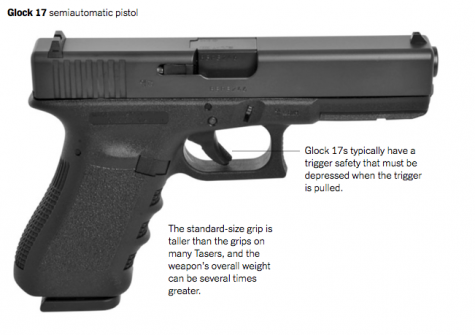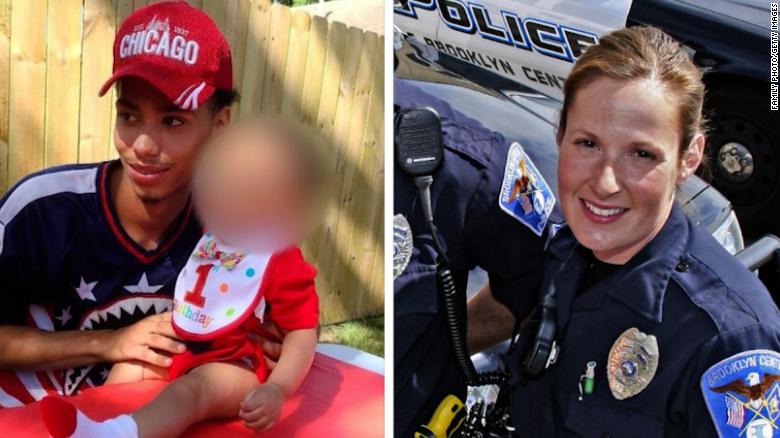Daunte Wright’s murder was no accident-but a willful act perpetrated by refusal to reform gun control, criminal justice laws
20 year-old Daunte Wright was killed by police veteran of 26 years Kim Potter. Potter claims she mistook her gun for her taser.
On April 11, 2021, Kimberly Potter, a cop of 26 years, shot 20-year-old black male Daunte Wright during a traffic stop in Brooklyn Center, Minnesota. The police chief claims that Potter mistook her taser for her handgun. Potter and supporting officer’s body cam footage has been released showing the stop taking place. Daunte Wright who had been pulled over for having expired registration tags, later found to have an arrest warrant for an armed robbery, is seen from body cam videos stepping out of the car as an assisting officer begins to place handcuffs on him. A few moments later, Wright tries to escape the grip of the officer, and gets back into the car when Potter is heard repeatedly shouting “Taser!” while aiming her firearm at Wright before fatally shooting him in the chest.
**Viewers discretion advised: video shows officer Potter pulling out her gun and shooting Wright**
Immediately after Wright was shot, officer Potter responds with “Holy s**t, I just shot him,” as if it was a shock to her.
A statement given by Brooklyn Center police chief Tim Gannon explains how Potter uses the protocol for using a taser, notifying the subject and fellow officers that she is going to deploy her taser, however this was not the case.
“As you can hear, the officer, while struggling with Mr. Wright yells ‘Taser! Taser!’ several times. That is part of the officer’s training prior to deploying a Taser, which is a less lethal device… As I watch the video and listen to the officer’s commands, it is my belief that the officer had the intention to deploy their Taser, but instead shot Mr. Wright with a single bullet.” – Tim Gannon
Kimberly Potter has been charged with second degree manslaughter, while former chief Gannon has resigned from his position after repeated calls to step down, including from the Brooklyn Center mayor Mike Elliot who says that police can’t afford to “make mistakes that lead to loss of life.”
However, it is questionable whether Potter’s use of a firearm instead of a non-life threatening taser was truly an accident. In the video, officer Potter can be seen aiming her firearm directly at the subject for a few seconds before shooting him. It should also be noted that the pistol and taser used by the officer both have trigger safeties, with the two having obvious weight and feel differences. According to the New York Times, the glocks used by police have a trigger safety that can be felt when touching the trigger, while the taser does not. The following images highlight the difference between the two. While the handgun and taser shown might not be the exact models used in the instance, they are similar to what any officer would be carrying.


The difference in color of the two is also very noticeable.

As recalled by the former police chief, officers usually keep their handguns on their dominant side of their body, and their taser on their non-dominant side to prevent this kind of switch up. California Deputy sheriff Ed Obayashi recalls that when officers use their dominant hand to draw both weapons, they use a cross draw when drawing a taser from the left hand side, which may be harder to differentiate in high-pressure situations.
If the incident was truly a mistake, Chicago police sergeant Betsy Smith provides the most reasonable explanation for this unreasonable outcome (Via NBC News).
“It’s not like she looked at her gun and thought it was a Taser… It’s a horrible, horrible motor glitch that could happen in high-stress situations. I liken it to when you get into a rental car and go to start it up, you automatically reach for what’s familiar to you before realizing that you’re not in your car. The same issue could have happened here with the Taser.”
Some are quick to mention that many officers get killed in what should be routine traffic stops, creating a very high-pressure situation from the start.
Even with the intentional use of a taser, the Brooklyn Police Department policy manual states that when using a taser, “reasonable efforts should be made to target lower center mass and avoid the head, neck, chest and groin.” Wright was shot in the chest.
In the footage, Potter can be seen holding her pistol for a good amount of time in front of Wright before firing. Along with the obvious differences that a police veteran of 26 years and a former police union president, should be aware of, this makes it harder to believe the incident was an accident.
Whether or not Wright’s death was an accident, it is unacceptable for any police officer to wrongfully take the life of another person. The fact that an officer of 26 years is capable of making such a mistake, intentional or not, perpetuates the fear of police officers, especially by black men who are targeted today. Potter’s mistake and the “mistakes” of countless others has sent a message that cops have the power to kill with impunity.
This isn’t the first time we have seen an “accidental” shooting of a (black) man.
In 2009, 22 year old Oscar Grant was killed at the Fruitvale BART Station in Oakland, California by officer Johannes Mehserle, who claimed he accidentally used his gun instead of his taser.
Bystander footage of the shooting released by the court shows otherwise (7:16).
Documented footage of the scene shows Grant in a struggle with two officers, including Mehserle, with three more present, when Mehserle pulls out his gun, stands up, and aims and shoots Grant in the back while he lay face down. Even with five cops present, former officer Mehserle felt the need to use his firearm, which eventually led to Grant’s death.
Many say that officers train a lot more with drawing and firing their handguns than they do with their tasers, which they claim explain an officer’s tendency to use their fire arms, whether accidental or not. However, there might be a bigger issue at hand- the prevalence of guns in circulation in the United States today.
The American Public Health Journal states that the homicide rate goes up by .9 percent per percentage point increase with gun ownership. Similarly, according to a Vox News article, studies have found that weaker gun control laws correlate with higher rates of killings by police officers, who fear civilians may be carrying a weapon.
According to The Atlantic: “Where guns are abundant, civilians are more likely to kill civilians and cops, and cops are, in turn, more likely to kill civilians.”
In an environment where guns are more prevalent, anxiety by police officers is going to be heightened. This environment paired with an officer who is improperly trained can lead to a deadly situation.
Philando Castile was shot 7 times by officer Jeronimo Yanez under the suspicion that he was going to pull out his personal gun when reaching for his wallet after being pulled over. An article by Derek Thompon at the Atlantic gives us a snapshot of the incident.
“ In the summer of 2016, in the suburbs of St. Paul, Minnesota, Castile, a 32-year-old black man, was pulled over in a car he was driving, along with his partner and her 4-year-old daughter.
‘How are you?’ Castile asked the approaching officer, according to a published transcript.
‘Good,’ said the cop, a 28-year-old Hispanic American named Jeronimo Yanez. At the driver-side window, he asked for a license and proof of insurance.
‘Sir, I have to tell you,’ Castile said, ‘I have a firearm on me.’ As his mother would later tell The New York Times, she had instructed her son to “comply, comply, comply” with law enforcement. So he did.
The statement made the officer nervous. ‘Don’t reach for it,’ Yanez said. The gun, he meant.
‘I’m,’ Castile replied, ‘I was reaching for—’ The wallet, he meant.
‘Don’t pull it out!’
‘I’m not pulling it out.’
‘He’s not pulling it out,’ Castile’s partner affirmed.
‘Don’t pull it out!’ Yanez yelled again. Then the officer unholstered his own gun and fired seven shots at point-blank range. Five bullets hit Castile. Two pierced his heart. Within minutes, he was dead. A licensed firearm sat untouched in the dead man’s pocket. Philando Castile was shot and killed reaching for his wallet. ”
The presence of the firearm alone was enough for officer Yanez to send not 1 but 7 shots into the family’s car.
U.S. police training seems substantially inadequate compared to other countries such as Norway in which trainee officers must complete a three-year bachelor’s degree, one year studying society and ethics, whereas in the U.S., officers spend an average of 21 weeks in military-like bootcamps, as mentioned by The Atlantic.
Your donation will support the student journalists of Carnegie Vanguard High School. Your contribution will allow us to cover our annual website hosting costs and fund field trips, competition fees, and equipment. We appreciate your support!

HEY! My name is Emma Pierce and I'm a senior. I am apart of the girls soccer team and love photography






